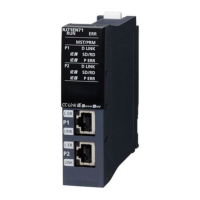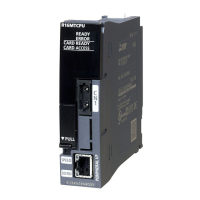68
1 FUNCTIONS
1.5 Communications Using the Fixed Buffer
1.5 Communications Using the Fixed Buffer
Communications using the fixed buffer uses TCP/IP and UDP/IP to send and receive arbitrary data with the external device
connected to the Ethernet with dedicated instructions in the same manner as exchanging data with socket communications.
Exchanges arbitrary data between the CPU module and external device using the fixed buffer of the RJ71EN71 and the
RnENCPU (network part).
The following table lists the differences with socket communications are given below.
Precautions
The CPU module (CPU part for the RnENCPU) cannot exchange data with the fixed buffer.
Differences between the "Procedure Exist" and "No Procedure"
control methods
"Procedure Exist" and "No Procedure" control methods can be used for fixed buffer communication. The following table lists
the differences between "Procedure Exist" and "No Procedure".
*1 The following value is used if the RJ71EN71 network type is set to "Q Compatible Ethernet".
Procedure Exist: Maximum 1017 words (binary code), maximum 508 words (ASCII code)
No Procedure: Maximum 2046 bytes
Setting procedure
Set "External Device Configuration" under "Basic Settings". ( Page 244 External Device Configuration)
1. Select the external device to be connected in "Module List" and drag it to "List of devices" or "Device map area".
2. Set "Communication Method" for the external device to "Fixed Buffer (Procedure Exist)" or "Fixed Buffer (No
Procedure)".
3. Set the "Fixed Buffer Send/Receive Setting".
4. Set the other parameters required for communication in the connection.
Item Differences
Socket communications Communications using the fixed buffer
Connection send/receive Send/receive is possible with one connection Specify send or receive for one connection
(Two connections are required for send and
receive)
Item Differences
Procedure Exist No Procedure
Message format Data is sent and received with the predetermined
data format.
Data is sent and received according to the external
device's message format.
Response for received data A response is sent for the received data. No response is sent for the received data.
Data Code Data can be exchanged with binary code or ASCII
code.
Data is exchanged only with binary codes.
Data length specified with dedicated instructions Specify with a number of words. Specify with a number of bytes.
Amount of application data per data exchange
session
*1
Maximum 5113 words (binary code)
Maximum 2556 words (ASCII code)
Maximum 10238 bytes
External device name Description
UDP Connection Module Select to communicate with the external device using UDP/IP
Active Connection Module Select to perform the open processing to the external device from the Ethernet-equipped module (Active open)
and communicate using TCP/IP.
Unpassive Connection Module Select to receive the open processing from an unspecified external device (Unpassive open) and communicate
using TCP/IP.
Fullpassive Connection Module Select to receive the open processing from the specified external device (Fullpassive open) and communicate
using TCP/IP.

